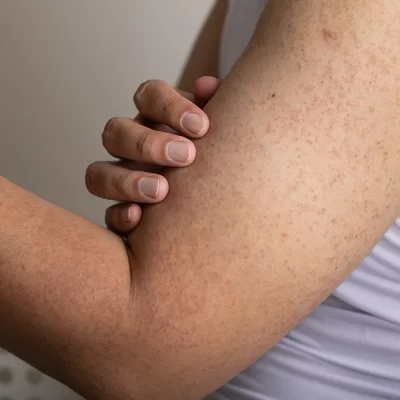Hornification of the epidermis
- What is follicular hyperkeratosis?
- What are the symptoms of follicular keratosis and where does it occur?
- What is the cause of keratosis pilaris?
- What are the types of keratosis pilaris?
- How to take care of skin with follicular hyperkeratosis?
- What treatments and medications are used for follicular hyperkeratosis?
- What diet to follow for keratosis pilaris?
What is follicular hyperkeratosis?
Follicular hyperkeratosis is a common and mild skin condition. It has a genetic basis and is classified as a disorder of keratinization.
In this condition, the skin excessively keratinizes, especially at the openings of hair follicles. This phenomenon, called hyperkeratosis, involves the accumulation of excess keratin - a protein that is the main component of the epidermis. The excess keratin blocks the hair follicles, leading to the formation of hardened plugs, visible as small bumps on the skin. Although it is a chronic condition, it is usually treated only as a cosmetic defect, not posing a serious health threat.
Follicular hyperkeratosis manifests as small, hard bumps that make the skin feel rough to the touch, resembling "goosebumps." It is often accompanied by redness around the hair follicles and dry skin. Sometimes there may also be itching or burning sensations.
Typically, these changes occur on the arms, thighs, and buttocks. In very young children, they may also appear on the face. The symptoms tend to worsen during the winter months due to lower air humidity.
It is important to avoid scratching the affected areas, as it can lead to inflammation, ingrown hairs, and even the formation of unsightly pigmentation.
Follicular hyperkeratosis is a characteristic disorder of keratinization of the skin, which has a genetic basis and affects hair follicles. It is inherited in an autosomal dominant manner, often confirmed by detailed family history.
Despite the genetic predisposition to the disease, certain factors can exacerbate the visibility of skin changes. The most important ones include vitamin A deficiencies or issues with its absorption. Hormonal fluctuations typical of adolescence or pregnancy also have a significant impact. Furthermore, other dermatological conditions such as atopic dermatitis or ichthyosis can worsen the skin's condition. Additionally, dry skin, especially in winter, significantly exacerbates this problem.
Follicular keratosis occurs in three main variants, each characterized by unique features.
The most common form is white follicular keratosis. It is characterized by rough skin with numerous white or gray bumps, without visible signs of inflammation.
Another form of the disease is red follicular keratosis. It manifests as distinct redness around the bumps, often resembling acne.
The rarest and most serious form is atrophic follicular keratosis. It leads to progressive hair follicle atrophy, resulting in scar formation and permanent baldness in affected areas.
In the care of skin with follicular hyperkeratosis, two key pillars are crucial: regular removal of dead skin and intensive skin moisturization.
It is worth reaching for appropriate exfoliating agents. Effective will be urea at a concentration above 10%. Equally beneficial are AHA acids, such as lactic acid, as well as salicylic acid (BHA). They prevent excessive skin keratinization.
Intensive moisturizing is crucial for rebuilding the skin's natural protective barrier. It is recommended to use dermocosmetics containing:
-
emollients (e.g., shea butter, plant oils) - protecting the skin from moisture loss,
-
humectants (glycerin, hyaluronic acid) - binding water in the epidermis,
-
ceramides - supporting skin regeneration,
-
niacinamide - supporting skin regeneration,
-
panthenol - soothing irritations,
-
allantoin - soothing irritations.
Avoid aggressive detergents, hot/chlorinated water, and mechanical rubbing of the skin. Gentle dry brushing of the skin supports the removal of dead skin.
The therapy of follicular keratosis aims to normalize the keratinization process and alleviate the troublesome symptoms of the disease.
In daily care, topical therapy often involves the use of retinoids such as tazarotene or adapalene, as well as calcipotriol. In more severe cases, a dermatologist may recommend oral treatment, for example, isotretinoin or acitretin.
Complementary treatment includes professional cosmetology procedures that effectively support therapy. These include:
-
chemical peels, e.g., with glycolic acid,
-
hydropeeling,
-
laser treatments, e.g., CO2 laser and vascular lasers that reduce redness and improve overall skin texture,
-
laser hair removal, especially helpful in cases of ingrown hairs,
-
spa therapies, e.g., using sulfuric waters.
Although diet will not cure follicular hyperkeratosis, it can significantly support therapy and alleviate symptoms of the disease. A balanced diet rich in anti-inflammatory nutrients is important. Your skin will especially appreciate a diet rich in:
-
Vitamin A,
-
Vitamin C,
-
Vitamin D,
-
Vitamin E,
-
B vitamins,
-
Zinc,
-
Unsaturated fatty acids, especially omega-3, known for their anti-inflammatory properties.
In case of identified nutritional deficiencies, it is always worth consulting a doctor who can recommend targeted supplementation.
To avoid exacerbations of the disease, limit the consumption of processed foods and products with pro-inflammatory effects.

